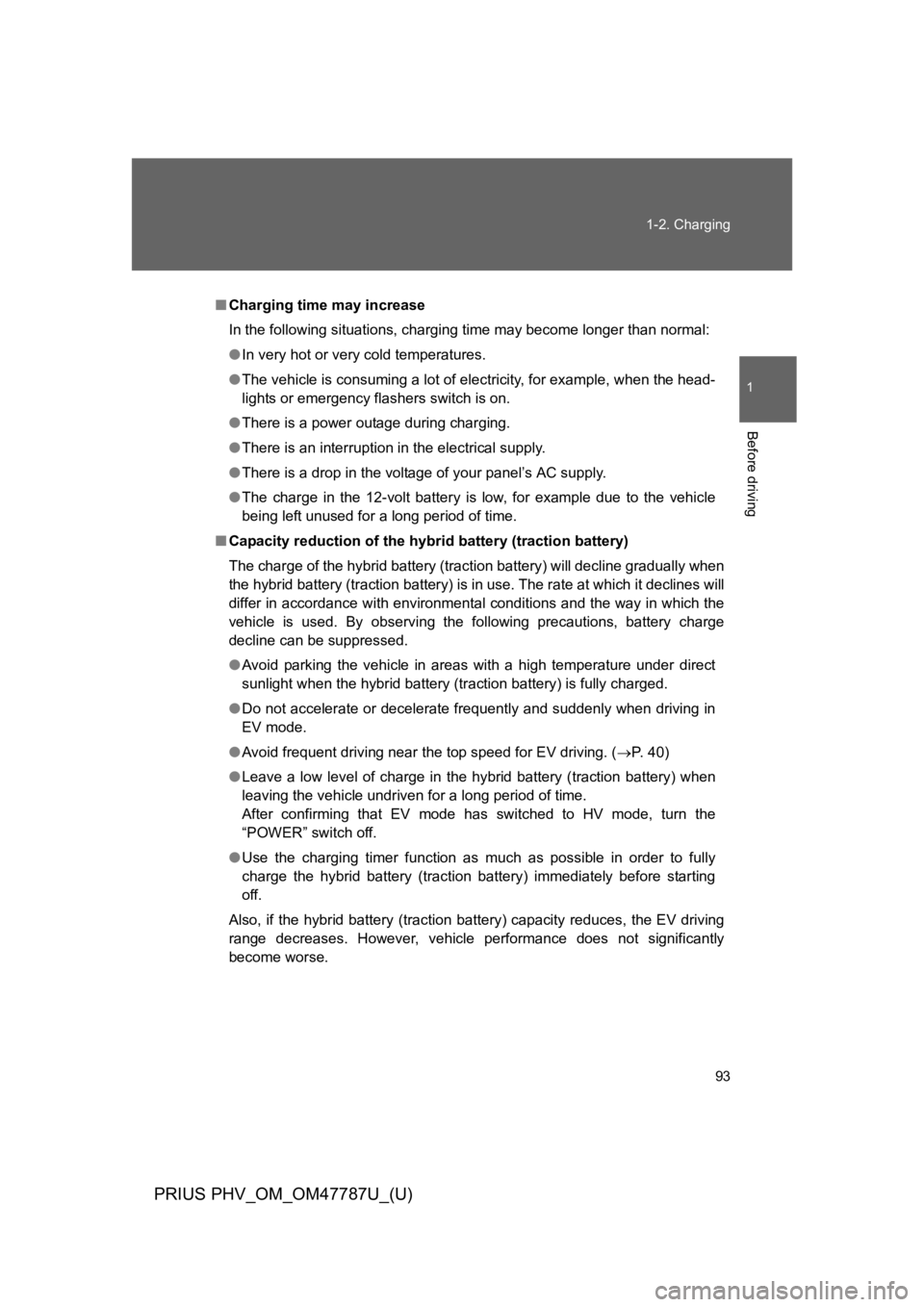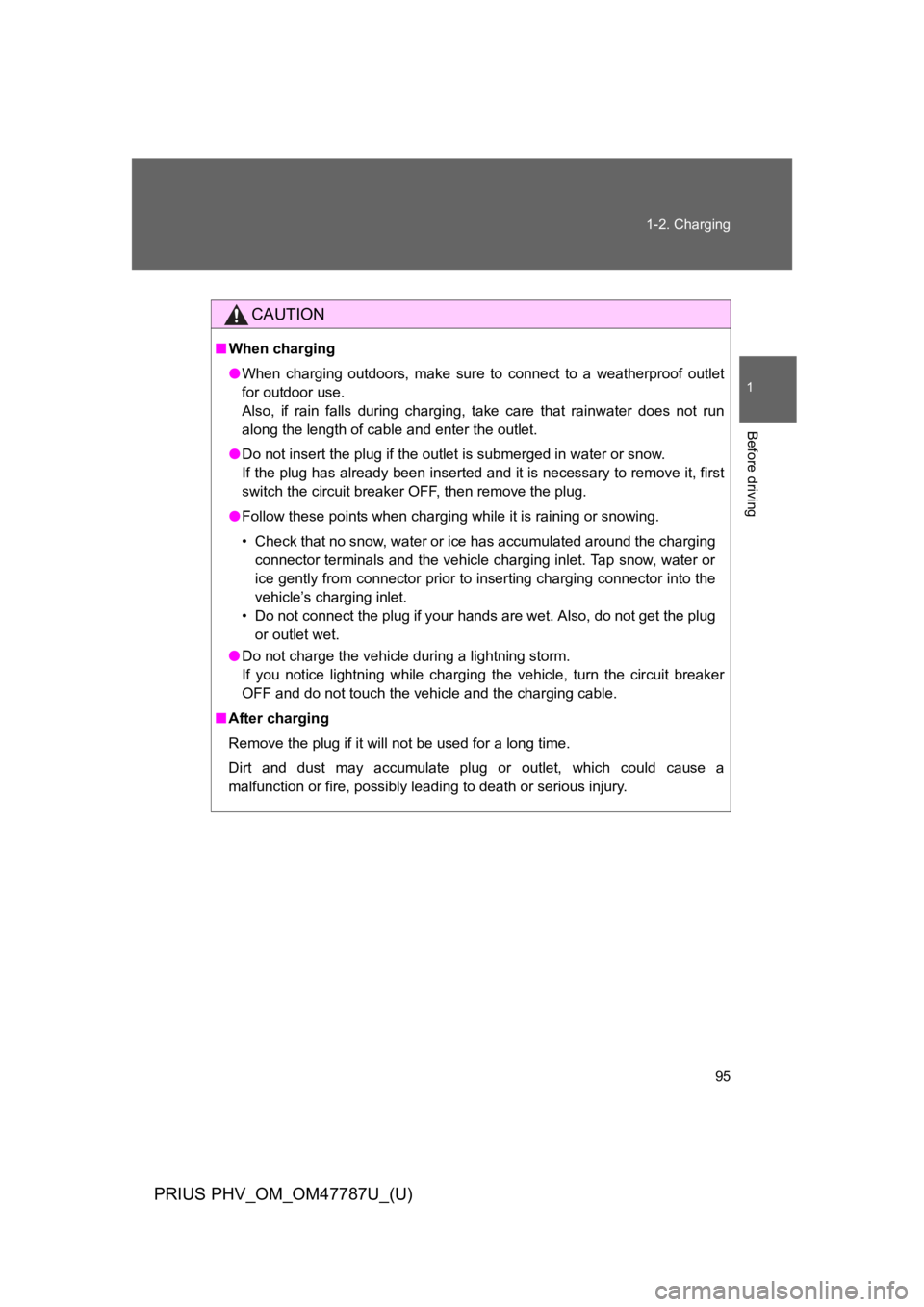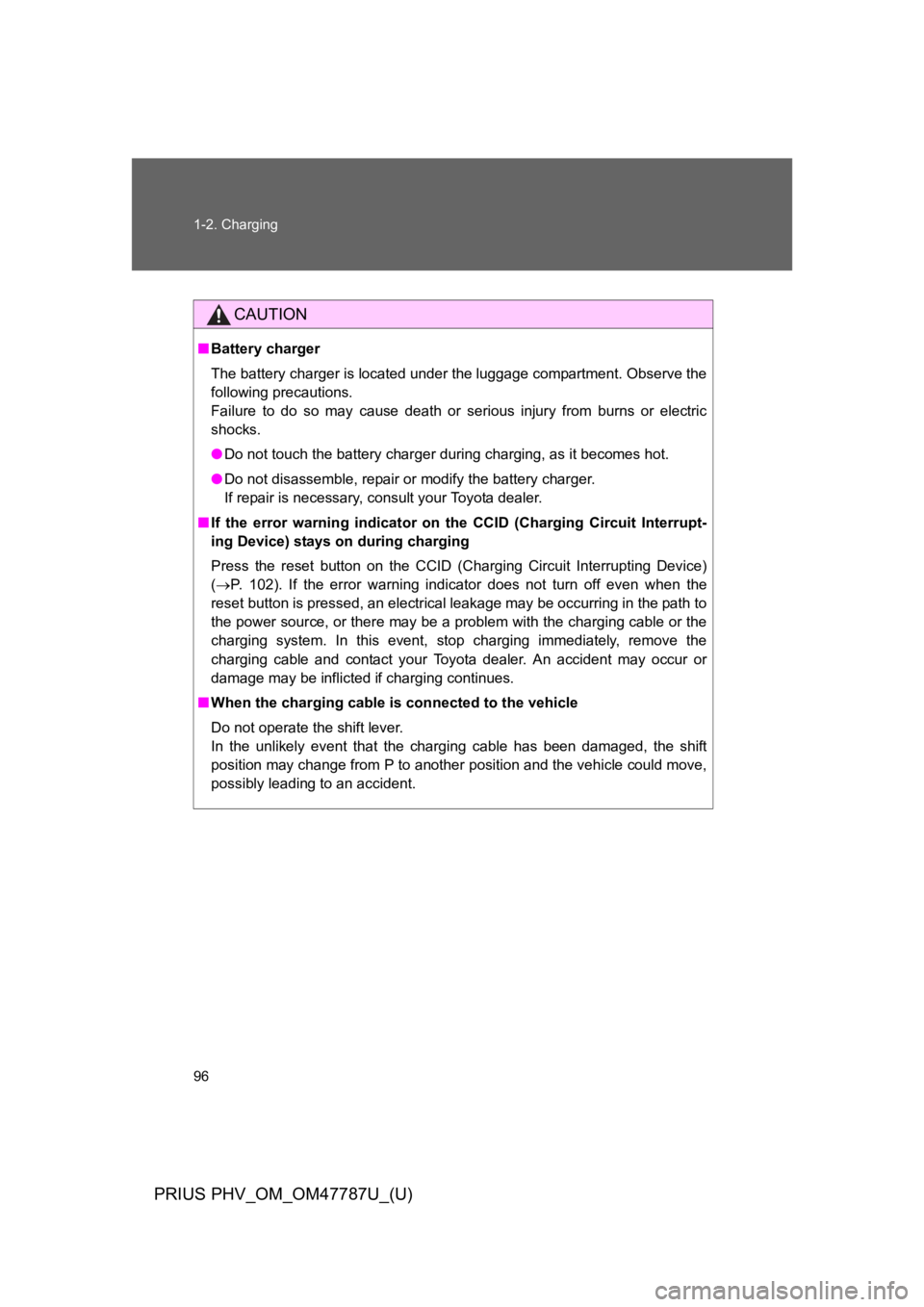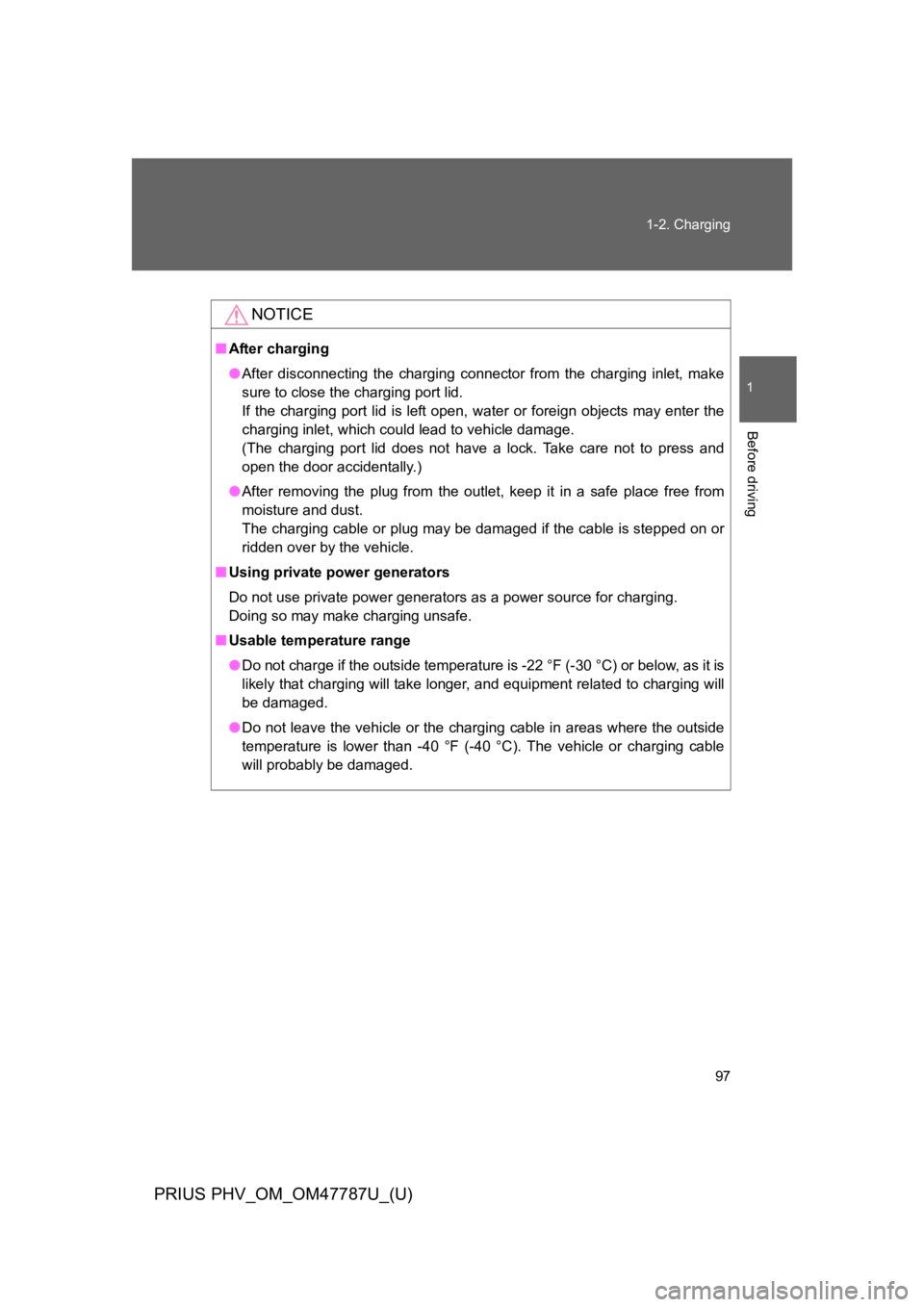Page 119 of 704

92
1-2. Charging
PRIUS PHV_OM_OM47787U_(U)
■Charging timer function (finish time setting mode)
●The finish time setting mode should only be used as a reference for the
time at which charging will finish.
Charging may not complete at the finish time depending on the effects of
the electricity supply, temperature etc. In this event, charging will continue
until completed.
●If the function detects that charging cannot be finished on time, charging
will start immediately, and will continue until fully charged.
■Charging indicator
●The charging indicator illuminates if the Remote Air Conditioning System
(→P. 3 7 1 ) i s u s e d d u r i n g c h a r g i n g o r w h i l e t h e c h a r g i n g c a b l e i s c o n -
nected.
●If a system malfunction occurs during charging or during Remote Air
Conditioning System use, the indicator will flash for approximately 10
seconds and then turn off.
■When the outside temperature is low or high
The level shown on the remaining charge display (→P. 60) may drop slightly
when the “POWER” switch is turned to ON mode, even if charging has been
completed and the hybrid battery (traction battery) is fully charged. However,
this does not indicate a malfunction.
■Using a DC Charger
DC Chargers cannot be used with this vehicle.
Page 120 of 704

93
1-2. Charging
1
Before driving
PRIUS PHV_OM_OM47787U_(U)
■Charging time may increase
In the following situations, charging time may become longer than normal:
●In very hot or very cold temperatures.
●The vehicle is consuming a lot of electricity, for example, when the head-
lights or emergency flashers switch is on.
●There is a power outage during charging.
●There is an interruption in the electrical supply.
●There is a drop in the voltage of your panel’s AC supply.
●The charge in the 12-volt battery is low, for example due to the vehicle
being left unused for a long period of time.
■Capacity reduction of the hybrid battery (traction battery)
The charge of the hybrid battery (traction battery) will decline gradually when
the hybrid battery (traction battery) is in use. The rate at which it declines will
differ in accordance with environmental conditions and the way in which the
vehicle is used. By observing the following precautions, battery charge
decline can be suppressed.
●Avoid parking the vehicle in areas with a high temperature under direct
sunlight when the hybrid battery (traction battery) is fully charged.
●Do not accelerate or decelerate frequently and suddenly when driving in
EV mode.
●Avoid frequent driving near the top speed for EV driving. (→P. 4 0 )
●Leave a low level of charge in the hybrid battery (traction battery) when
leaving the vehicle undriven for a long period of time.
After confirming that EV mode has switched to HV mode, turn the
“POWER” switch off.
●Use the charging timer function as much as possible in order to fully
charge the hybrid battery (traction battery) immediately before starting
off.
Also, if the hybrid battery (traction battery) capacity reduces, the EV driving
range decreases. However, vehicle performance does not significantly
become worse.
Page 121 of 704

94
1-2. Charging
PRIUS PHV_OM_OM47787U_(U)
CAUTION
■When charging
Follow these points when charging. If you do not follow them, fire or electri-
cal shock may occur, possibly resulting in death or serious injury.
●Connect to a power source suitable for charging. (→P. 7 7 )
●Check that the outlet, charging cable and charging inlet are not damaged.
●Check that the tips of the plug have not been deformed.
●If the plug is dirty or dusty, clean it before inserting.
●Plugging into the outlet that is located in a spot that is not high above the
ground or floor is recommended.
●Insert the plug firmly into the outlet.
●Do not touch the electrical terminals of the charging connector or short it
with foreign objects.
●Do not get water in the charging inlet.
Do not wash the vehicle while the charging cable is connected to the vehi-
cle. (→P. 4 2 6 )
●Do not touch metal objects or pointed objects (needles etc.) to the port of
the charging inlet.
●Do not charge if the charging cable is coiled or bundled.
●Wrapping 120 V charging cable while in-use is not recommended because
cable may overheat. Failure to rewrap charging cable when not in-use
could result in strangulation or tripping hazard.
●After connecting the charging cable, confirm that it is not bent.
●Do not place heavy objects on the charging cable.
●If charging is interrupted, remove the charging connector before removing
the plug.
Page 122 of 704

95
1-2. Charging
1
Before driving
PRIUS PHV_OM_OM47787U_(U)
CAUTION
■When charging
●When charging outdoors, make sure to connect to a weatherproof outlet
for outdoor use.
Also, if rain falls during charging, take care that rainwater does not run
along the length of cable and enter the outlet.
●Do not insert the plug if the outlet is submerged in water or snow.
If the plug has already been inserted and it is necessary to remove it, first
switch the circuit breaker OFF, then remove the plug.
●Follow these points when charging while it is raining or snowing.
•Check that no snow, water or ice has accumulated around the charging
connector terminals and the vehicle charging inlet. Tap snow, water or
ice gently from connector prior to inserting charging connector into the
vehicle’s charging inlet.
•Do not connect the plug if your hands are wet. Also, do not get the plug
or outlet wet.
●Do not charge the vehicle during a lightning storm.
If you notice lightning while charging the vehicle, turn the circuit breaker
OFF and do not touch the vehicle and the charging cable.
■After charging
Remove the plug if it will not be used for a long time.
Dirt and dust may accumulate plug or outlet, which could cause a
malfunction or fire, possibly leading to death or serious injury.
Page 123 of 704

96
1-2. Charging
PRIUS PHV_OM_OM47787U_(U)
CAUTION
■Battery charger
The battery charger is located under the luggage compartment. Observe the
following precautions.
Failure to do so may cause death or serious injury from burns or electric
shocks.
●Do not touch the battery charger during charging, as it becomes hot.
●Do not disassemble, repair or modify the battery charger.
If repair is necessary, consult your Toyota dealer.
■If the error warning indicator on the CCID (Charging Circuit Interrupt-
ing Device) stays on during charging
Press the reset button on the CCID (Charging Circuit Interrupting Device)
(→P. 1 0 2 ) . I f t h e e r r o r w a r n i n g i n d i c a t o r d o e s n o t t u r n o f f e v e n w h e n t h e
reset button is pressed, an electrical leakage may be occurring in the path to
the power source, or there may be a problem with the charging cable or the
charging system. In this event, stop charging immediately, remove the
charging cable and contact your Toyota dealer. An accident may occur or
damage may be inflicted if charging continues.
■When the charging cable is connected to the vehicle
Do not operate the shift lever.
In the unlikely event that the charging cable has been damaged, the shift
position may change from P to another position and the vehicle could move,
possibly leading to an accident.
Page 124 of 704

97
1-2. Charging
1
Before driving
PRIUS PHV_OM_OM47787U_(U)
NOTICE
■After charging
●After disconnecting the charging connector from the charging inlet, make
sure to close the charging port lid.
If the charging port lid is left open, water or foreign objects may enter the
charging inlet, which could lead to vehicle damage.
(The charging port lid does not have a lock. Take care not to press and
open the door accidentally.)
●After removing the plug from the outlet, keep it in a safe place free from
moisture and dust.
The charging cable or plug may be damaged if the cable is stepped on or
ridden over by the vehicle.
■Using private power generators
Do not use private power generators as a power source for charging.
Doing so may make charging unsafe.
■Usable temperature range
●Do not charge if the outside temperature is -22 °F (-30 °C) or below, as it is
likely that charging will take longer, and equipment related to charging will
be damaged.
●Do not leave the vehicle or the charging cable in areas where the outside
temperature is lower than -40 °F (-40 °C). The vehicle or charging cable
will probably be damaged.
Page 125 of 704
98
1-2. Charging
PRIUS PHV_OM_OM47787U_(U)
When normal charging cannot be carried out
If charging does not commence even though the correct procedure
has been carried out, and an error message is shown on the multi-
information display, try the correction procedures listed in the table
below.
If you still cannot correct the problem, contact your Toyota dealer.
Page 126 of 704
99
1-2. Charging
1
Before driving
PRIUS PHV_OM_OM47787U_(U)
A problem has occurred during charging
Refer to the following table and carry out the appropriate correction
procedure.
SituationReasonCorrection procedure
The power indicator on
the CCID (Charging
Circuit Interrupting
Device) does not illumi-
nate even when con-
nected to a power
source
The plug is not properly
connected with the out-
let.
Insert the plug firmly
into the outlet.
There is a power out-
age.
Restart charging once
power has been
restored.
The circuit breaker has
activated.
Check the circuit
breaker.
If there is nothing
unusual, connect to
another outlet and
check that charging is
possible.
If charging is possible,
there is probably a
problem with the first
outlet. Contact your
building manager or an
electrician.
The charging cable
connecting the CCID
(Charging Circuit Inter-
rupting Device) with
the plug is damaged.
Stop charging immedi-
ately, and contact your
To y o t a d e a l e r .